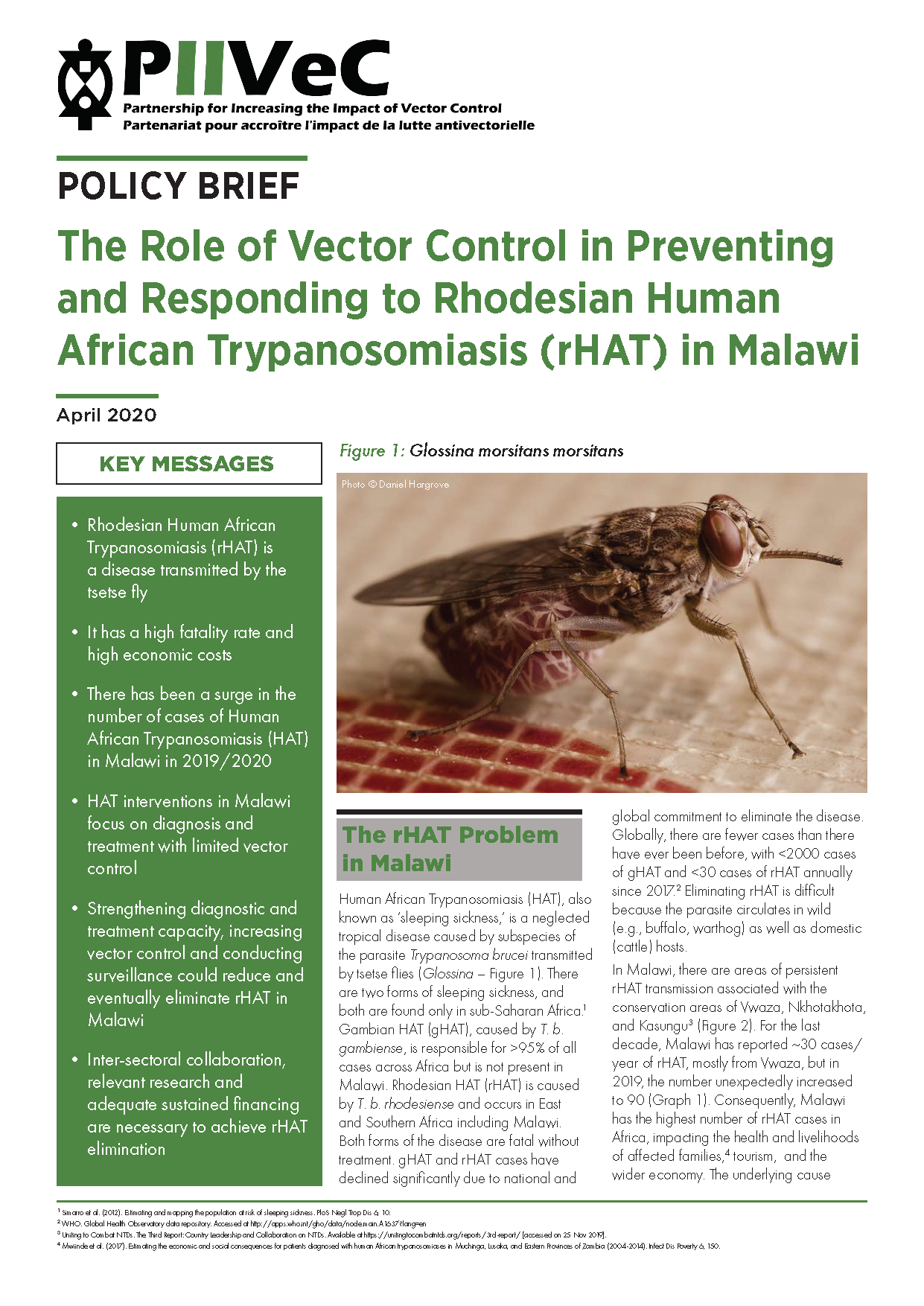Policy Briefs

An Assessment of Knowledge, Attitudes, Perception and Practice
about COVID-19 among the Kenyan Population

Human African Trypanosomiasis (HAT), also known as ‘sleeping sickness,’ is a neglected tropical disease caused by subspecies of the parasite Trypanosoma brucei transmitted by tsetse flies. There has been a surge in the number of cases of Human African Trypanosomiasis (HAT)in Malawi in 2019/2020. HAT interventions in Malawifocus on diagnosis and treatment with limited vector-control. Strengthening diagnostic and treatment capacity, increasing vector-control and conducting surveillance could reduce and eventually eliminate rHAT in Malawi.

Malawi is planning the 2021 insecticide-treated net (ITN) distribution campaign to potentially include the deployment of Interceptor® G2 (IG2) nets. This policy brief aims to inform this decision by presenting: current evidence supporting the efficacy and use of IG2 nets; and plans for PIIVeC research to address key evidence gaps.

Healthy, well-qualified and highly competent workers are essential for Angola to exploit the potential of its population and enjoy the Demographic Dividend (DD). The dividend demographic is the accelerated economic growth that can occur when a country invests to significantly reduce the high fertility rates, leading to a change in the age structure of the population, leaving a structure where there is a predominance of children dependent for one where there are more people of working age. However, the total economic potential of this age-old population can improve considerably if investments are made in the development of human capital.

Angola’s Long-Term Development Strategy, Vision 2025, aims to lift the country out of poverty by promoting growth economic, macro-economic stability, jobs and equality, taking advantage of the country’s considerable natural resources and its potential to create opportunities for all its citizens. Angola is currently classified as a low-middle income country, with a GDP per capita estimated at US $ 3,879. A growth rate impressive economic performance, averaging more than 10% annually between 2006 and 2010, it reduced to more than half (4.7%) between 2011 and 2015 as a result of the sudden and prolonged decline in oil prices oil, which represent more than 95% of the income from export from Angola. Despite being a middle-income country, Angola faces many socio-economic challenges that have placed it among the low human development countries (ranked 150th 188 countries in 2015).

Angola is a low-middle income country, with an estimated GDP per capita at $ 3,879, an impressive rate of economic growth, averaging more than 10% annually between 2006 and 2010, has reduced more half (4.7%) between 2011 and 2015 as a result of the sudden and international oil prices, which represent over 95% of Angola’s export earnings. The fast population growth has impeded economic growth. Angola has one of the highest fertility rates in Africa sub-Saharan Africa, with an average of 6.2 children per woman. This resulted in high ratio of dependent children, which compromises the perspective of the country to achieve its Vision 2025 objective – reduce poverty promoting economic growth, macroeconomic stability and jobs.

Le sepsis est une maladie mortelle résultant d’une infection sévère et l’une des principales causes de décès évitables dans le monde. Vu l’important fardeau de l’infection, l’Afrique serait affligé par un taux disproportionné de sepsis dans le monde. Les coûts humains et financiers énormes associés au sepsis peuvent être attribués à la sous-priorisation dans les systèmes de santé en termes de ressources, de surveillance et de notification.

Globally, it is estimated that 1 billion people suffer from acute and chronic respiratory conditions, making them major causes of illness and death. Although there is a relative lack of data and evidence on lung health illnesses beyond tuberculosis (TB) in Sub-Saharan Africa (SSA), their estimated regional burden is large and growing. In addition, there is a poorly understood relationship between infections, such as TB, and non-infectious causes of lung health problems. The problem in lung health diseases in SSA is exacerbated by many factors, including under-prioritisation, under-treatment, and weak preventative measures.

Sepsis is a life-threatening condition resulting from severe infection and is a leading cause of preventable death worldwide. With its high burden of infection, Africa is expected to bear a disproportionate proportion of global sepsis. The huge human and financial costs associated with sepsis can be attributable to its under-prioritisation in health systems, in terms of resourcing, surveillance, and reporting. In low and middle-income countries (LMICs), including much of Africa, a significant proportion of sepsis can be attributed to the consequences of weak health systems, including poor sanitation and hygiene as well as poor quality health care.

Policy-makers in Uganda, Malawi, and Kenya have made progress with aligning medium and long-term development plans within a demographic dividend framework. Researchers in these countries have evaluated the investments needed to leverage the potential of their large youthful populations, but incorporating this research into policy requires collaboration between policymakers and experts.

Malawi has made tremendous progress in recent years toward the goal of ending child marriage. In 2015, Malawi adopted the Marriage, Divorce, and Family Relations Act, which set 18 as the legal minimum age for marriage, and in February 2017, a legal loophole allowing children between the ages of 15 and 18 to marry with parental consent was closed with an amendment to the Constitution.

This policy brief highlights the policy and programme options that Rwanda can adopt to enhance human capital development to optimise its chances of harnessing the demographic dividend. It is derived from the Rwanda DD study, which showed that the age structure that would result from a decline in birth rates from the current level of 4.2 births per woman to 2.3 births by 2050 would propel the country to graduate to middle-income status with per capita GDP of US$ 4,014 by 2035 and to high-income status with per capita GDP of US$ 12,555 by 2050.

